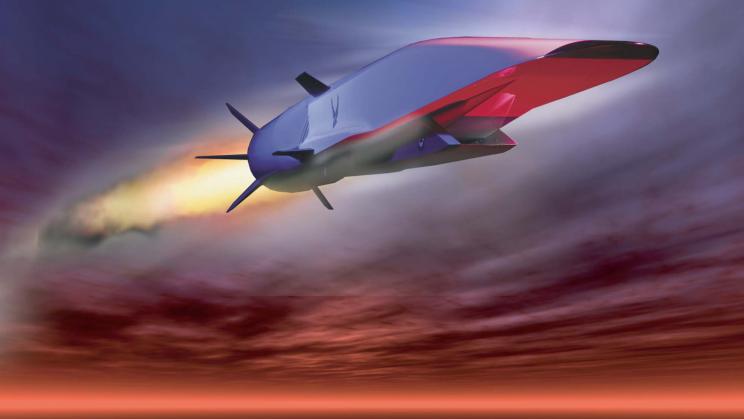Microwaves and turbulent air could kill China’s hypersonic missiles on the cheap.
By Jack Detsch
Stop if you’ve heard this: China and Russia’s nuclear-capable hypersonic weapons of the future are faster than a speeding bullet, more powerful than a ballistic missile, and able to evade the United States’ Earth-based missile defense sensors in a single bound.
But the stress of traveling at more than five times the speed of sound (the going tempo for hypersonics) gives them a higher risk of failure: Hypersonic missiles may have to cut through turbulent air and searing 4,000-degree heat, all while losing energy by making maneuvers during the flight.
That makes the margin for error pretty small; one unexpected air particle could damage the airframe. Experts think that bumpy ride could give the U.S. Defense Department a better chance to shoot down Beijing and Moscow’s superweapons—which have leaped ahead of the Pentagon’s arsenal—on the cheap. That’s according to a new report from the Center for Strategic and International Studies (CSIS), a Washington think tank. It calls on the Biden administration to roll out a new playbook for wide-ranging defenses that go beyond the Pentagon’s bullet-to-bullet missile defense systems, such as using planes to dispense unwelcome metallic particles in the direction of a rock-skipping hypersonic missile or using microwave beams aboard cruise missiles or drones to fry their internal circuits.
“Absent heavy mitigation measures, disruption of the hypersonic flowfield could lead to progressive deterioration of performance or a mission kill, if not outright catastrophic failure,” missile defense experts Tom Karako and Masao Dahlgren wrote in the report, released Monday. “Electrical, optical, thermal, or electromagnetic disruptions from directed-energy systems might stress the tight design margins of hypersonic weapons.”
Experts said that stopgap solutions might challenge China and Russia’s budgets and patience to develop hypersonics. The weapons’ vulnerability during flight makes them hard to use effectively and could also make them more susceptible to more varied defenses. “The need to overcome such uncertainties might force adversaries to embrace more conservative, less capable weapon designs,” Karako and Dahlgren wrote.
While the report turns a skeptical eye on high-priced lasers as a defense mechanism, microwave weapons could prove particularly tricky for China and Russia to harden hypersonic weapons against. High-powered radiation could penetrate the antennae, putting the interwoven radar guidance and navigation systems on board at risk, thereby disrupting the flight path. Karako and Dahlgren also want the Pentagon to think creatively about using exploding shards or the electromagnetic spectrum to cut into China and Russia’s edge.
There’s a sign that the Pentagon could be getting the message. With the Defense Department knee deep in reviews of the military’s nuclear and missile defense arsenals, set to be released in the coming weeks, there are signs that the Pentagon brass is beginning to think creatively about how to kill hypersonic weapons, as both China and Russia have leapfrogged U.S. development. (Both countries have already fielded hypersonic weapons, whereas the United States won’t be able to do so until 2023.) The growing gap was highlighted by two Chinese tests of a hypersonic missile last year that circumnavigated the globe, sounding alarms at the Pentagon.
The Biden administration has acknowledged that the United States is behind. While Washington began thinking about developing hypersonic weapons as far back as the George W. Bush administration, funding and focus lagged over the next two decades during the United States’ wars in Iraq and Afghanistan.
Heidi Shyu, the Pentagon’s top official for research and engineering, said in December 2021, she had come up with a list of asymmetric countermeasures to defeat the weapons and had plans to brief Defense Secretary Lloyd Austin on the game plan.

‘They’re So Destructive’: Russian Missiles Could Dominate Ukraine’s Skies
“Yes, we are behind,” she said. “But my job, given by [Austin], was looking for asymmetric ways to counter hypersonics.” Shyu said that the Pentagon has also struggled to consolidate brainstorming on hypersonics, which has been going on at the agency’s in-house tech incubator for decades, and pass it along to a single military service.
But the CSIS report stressed that none of the proposed asymmetric solutions are likely to be a silver bullet and would have to be undergirded by a system of missile defense sensors and an invigorated defense industrial base. While the Pentagon can detect the launch of a hypersonic weapon with Earth-based sensors, the agency can’t track the missiles since they fly below the observation horizon of detection systems.
The Trump administration first laid out the Pentagon’s path to putting up a space-based missile defense layer in 2019, but the Defense Department has only just given the go-ahead to L3Harris Technologies and Northrop Grumman to address the gap. There’s also the problem of hitting hypersonic weapons before they detach from a glide vehicle that helps them boost their way into space. The U.S. Missile Defense Agency is currently planning to develop limited defenses to intercept hypersonics before impact as well as a longer-term effort to target the weapons before they detach from the gliders.
“Developing and fielding such defenses will be challenging but not impossible,” the CSIS report concluded. “Hypersonic missiles are not unstoppable.”
Jack Detsch is Foreign Policy’s Pentagon and national security reporter. Twitter: @JackDetsch
Credit | Foreign Policy

